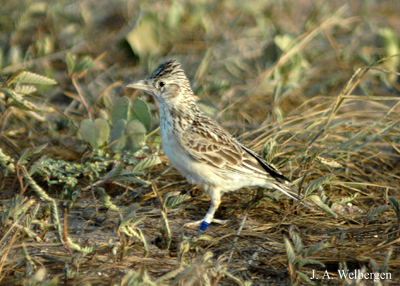- Raso Lark
Taxobox
name = Raso Lark

image_width = 250px
status = CR | status_system = IUCN3.1
regnum =Animal ia
phylum = Chordata
classis = Aves
ordo = Passeriformes
familia = Alaudidae
genus = "Alauda "
species = "A. razae"
binomial = "Alauda razae"
binomial_authority = Alexander, 1898The Raso Lark ("Alauda razae") is a small
passerine bird with a highly restricted range, being found only on Raso islet in theCape Verde Islands . Thiscritically endangered member of theAlaudidae lives in highly arid terrain, and is considered one of the least known birds in the westernPalaearctic region, due to its remoteness and the lack of much ornithological study on the archipelago as a whole.Description
The Raso Lark is restricted to one small island in the Cape Verde group, although historically it is believed to have ranged over two other islands, Branco and
Sao Vicente Island ; all three of these islands were joined in the lastIce Age . Branco island itself has no permanent water and has never been inhabited by people, a fact that has probably saved the lark from extinction until now.The Raso Lark feeds by digging in the ground for
insect larva e, andbulb s of the nutsedge. Both sexes also feed on grass seeds, and insects such as butterflies, moths andgrasshopper s. The female lays one to three eggs after the rains. Courtship behaviour is like that of theSkylark . The incubation time is thought to be 15 days.Threats
The tiny population size, last thought to be ~150 birds, coupled with the highly skewed sex ratio (around 2 males to each female) make this species one of real concern. The reproductive success of the birds is very low, probably due to predation by the near-endemic
Cape Verde giant gecko . The Neglected Kestrel "Falco (tinnunculus) neglectus" is a predator of Razo larks. Although the island is currently free of mammalianpredator s such asrat s orferal cat s, and is a closed reserve, the likelihood of a single unauthorized visit causing massive damage remains high. It has been suggested that establishing a second population on the gecko-free island of Santa Luzia, which historically might also have had the lark, should be a conservation priority.Gallery
References
* Database entry includes justification for why this species is critically endangered
*Donald, P. F., de Ponte, M., Pitta Groz, M. J., & Taylor, R. (2003). Status, ecology, behaviour and conservation of Raso Lark "Alauda razae". "Bird Conservation International" 13: 13-28.
*Donald, P. F., & Brooke, M. de L. (2006). An unlikely survivor: the peculiar natural history of the Raso Lark. "British Birds" 99: 420-430.External links
* [http://www.birdlife.org/datazone/species/index.html?action=SpcHTMDetails.asp&sid=8180&m=0 BirdLife Species Factsheet.]
Wikimedia Foundation. 2010.
